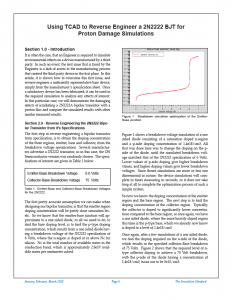Using TCAD to Reverse Engineer a 2N2222 BJT for Proton Damage Simulations
Section 1.0 – Introduction
It is often the case, that an Engineer is required to simulate environmental effects on a device manufactured by a third party. In such an event, the first issue that is faced by the Engineer, is a lack of access to the manufacturing process that created the third party device in the first place. In this article, it is shown how to overcome this first issue, and reverse engineer a sufficiently representative base device, simply from the manufacturer’s specification sheet. Once a satisfactory device has been fabricated, it can be used in the required simulation to analyze any effects of interest. In this particular case, we will demonstrate the damaging effects of irradiating a 2N2222A bipolar transistor with a proton flux and compare the simulated results with other similar measured results.
Section 2.0 – Reverse Engineering the 2N2222 Bipolar Transistor from it’s Specifications
The first step in reverse engineering a bipolar transistor from specification, is to obtain the doping concentration of the three regions, emitter, base and collector, from the breakdown voltage specifications. Several manufacturers advertise a 2N2222 transistor, so in this case, the ON Semiconductor version was randomly chosen.



